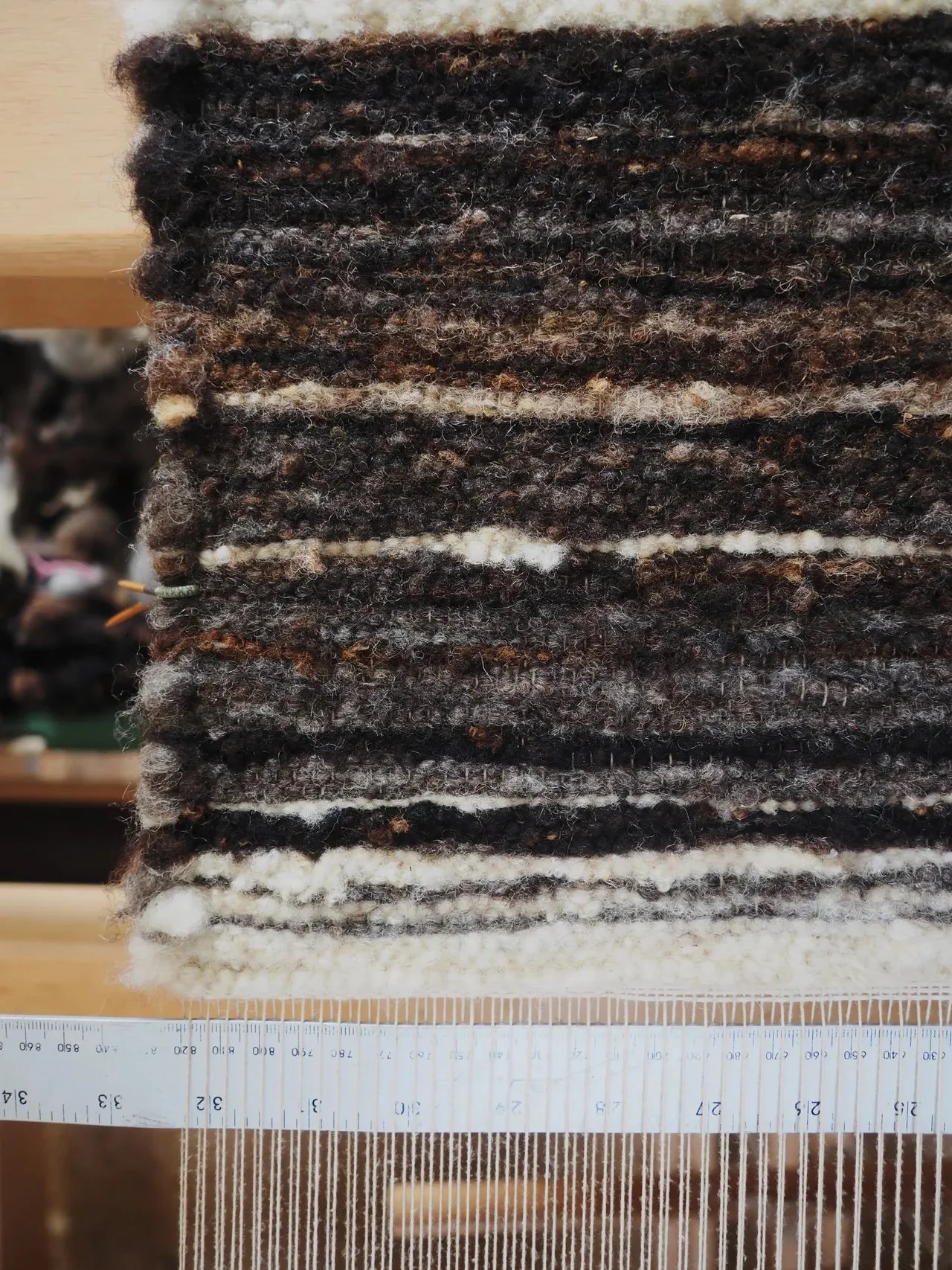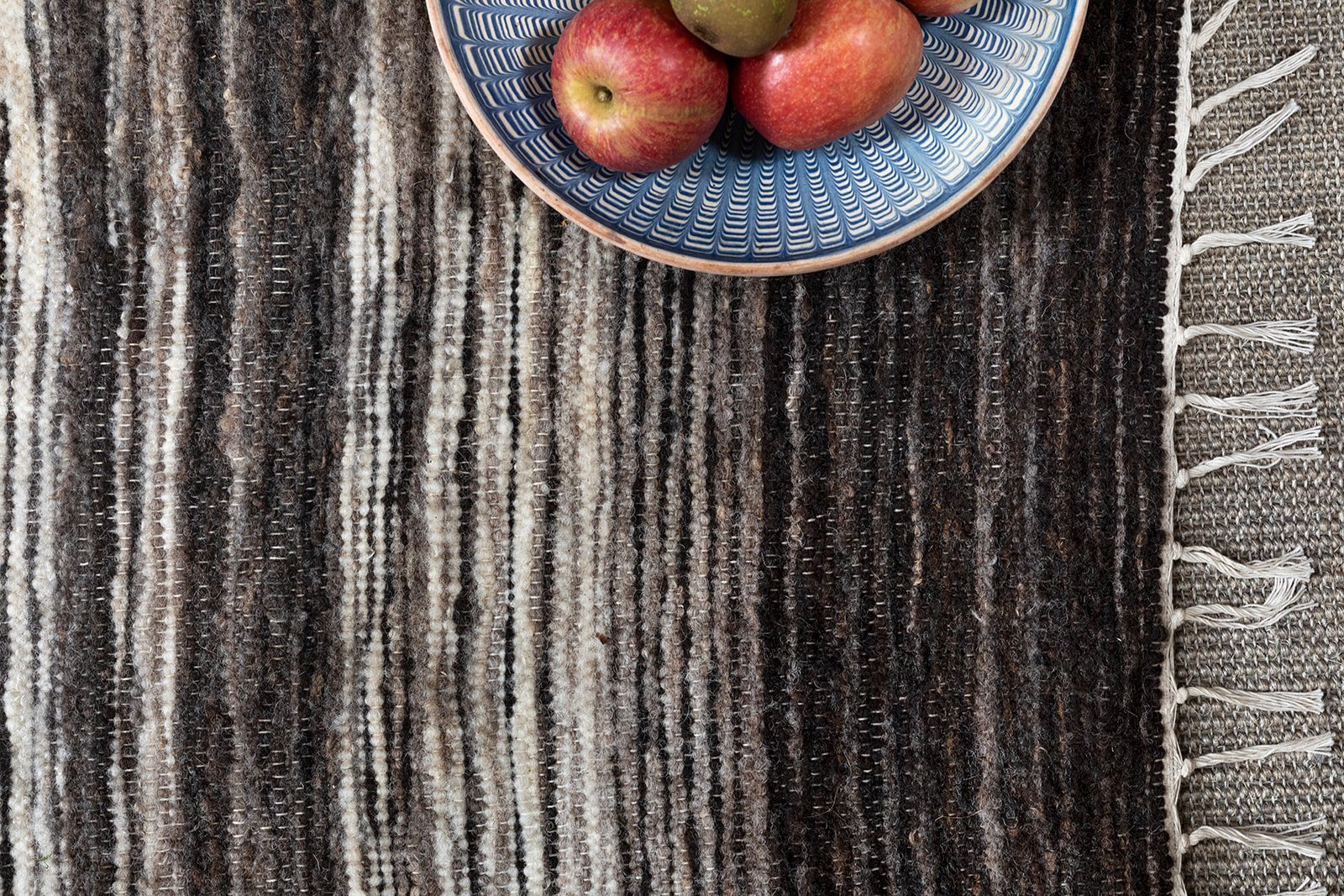The process from flock to loom
Weaving with raw wool, from my own sheep and others living nearby, makes my process very direct. For me, textile-making actually begins out in the fields around my studio, long before I sit at the loom.

Slow making
There is no getting away from it. Mine is a slow process.
It takes a year for sheep to grow the wool I use. Once I’ve gathered the fleece (I have started shearing my own flock by hand), my pieces take anywhere upwards of 20 hours weaving time.
I start by preparing my loom. Then I move on to the weaving itself, which – because I am working with fleece rather than yarn – involves shaping the wool into useable weft as I go.
When the weaving is complete, and the rug or wall hanging is off the loom, the piece requires finishing (knotting, sewing and gentle washing).
Wool growing
Rare & native breed sheep
The raw materials I use are so important to my whole process and are what turned me into a weaver in the first place.
I aim to put the colour and texture of natural, minimally processed wool at the centre of my work.
Working with fleece from rare and native breed sheep allows me to highlight their beautiful wool and use a range of colour, not just white.

Just-arrived Gotlands.

First shearing of Gotlands in my pasture.
My own sheep are cross-breeds between two of Britain’s rare, native breeds – Soay and Shetland. And I am excited to have just welcomed a small flock of grey Gotland sheep to the pasture.
Sourcing fleece is now becoming part of my process: in addition to wool grown just outside my studio, I am now using fleece from a Highland-bred pedigree Shetland flock.
I have also recently secured some rare breed merino fleece from a small flock grazing in the Algarvian countryside in Portugal, which I will be working with later this year when visiting family.
Gathering the wool
Last summer, while waiting for the small flock shearers to arrive, I decided to give clipping a go myself.
I ended up blade shearing, by hand, nearly half of my flock. I loved every minute.
I now intend to blade shear as many of my sheep as I can. I find this a slow and gentle process, allowing you to decide how close to shear the fleece and clip away any unusable parts.

Shearing the flock by hand.

Zara happily relieved of her heavy coat.
The sheep are very good natured about it, let me play country music as I go and appear quite relieved once you reach their shoulders and all this weight is lifted off them.
It is a lovely experience.




Processing the fleece
The journey from field to studio is very quick: after shaking off and picking out any vegetable matter I bundle the shorn fleece into a cardboard box.
The time-consuming fibre preparation comes later (during the weaving itself) when I am choosing, teasing out and shaping the pieces of fleece to use as my weft – the horizontal lengths of wool that form the most substantial part of my rugs.
My fleece processing is an extremely minimal version of the many stages that wool goes through in conventional yarn production before it arrives, wound onto cones, in a weaving studio.

Preparing the warp for dressing the loom.

Dressing the loom
Setting up the loom with all the necessary threads can be, depending on the loom, one of the most challenging aspects of weaving. It is extremely satisfying on completion.
Warping
The warp provides structure to my pieces: it’s the lengthwise set of threads that I weave my woolly weft into. I mostly use a cotton warp just now, but sometimes work with other natural fibres such as linen.
There are several processes involved in dressing the loom. I use my homemade warping board to get each warp thread (called a ‘warp end’) to exactly the same length and sitting in the right order.
The warp is then fed into the loom’s reed (‘sleying the reed’), the frame which keeps it from tangling and sets a consistent width. Then the warp ends are individually threaded into the relevant heddles that will allow me to lift sets of warp ends and weave in my weft.

With the warp set up correctly, I can lift sets of warp ends (threads) and weave in the wool that is my weft.
I tend to go into a loom fugue when the warp needs to be set up, only relaxing once I can start the gentle meditative process of weaving once again.
Practice makes perfect and the hardest and most useful lesson I have learnt is not to rush loom dressing as you will inevitably introduce mistakes that take twice as long to fix afterwards…
Design processes
With my designs I bounce between enjoying the structure of folIowing formal patterns I have created to display the contrasting fleece colours and working more loosely and intuitively.
Currently my favourite approach is to enjoy the free flow of blending the subtle gradients and array of shades and colours in a way that echoes the Highland landscapes – from the rolling hills & lochs around me to the coastal beachscapes of the Western Isles.


Working at the loom
Sitting down at my loom, morning coffee in hand, is one of my favourite moments of the day. It feels full of possibility.

Weft-making and weaving
I shape and craft the raw fleece into weft as I go; no two actions are the same nor two lengths or widths of weft. This makes the process so interesting and exciting to me – unpredictability and challenge drives me.
Weft-making is my equivalent of making or choosing yarn.
It is one of my favourite parts of the weaving process – indulgently creating my weft in the moment of making; contracting and condensing the wool processing aspects as tightly as possible, saving and not saving time simultaneously.
I use my hands to guide the weft between the warp ends and weave my fabric and a tapestry bobbin to help tighten and position as I go.
Weft-making combined with the actual weaving allows me to reach my flow state; weaving continues until I’m ready to take the piece off the loom.
Every fleece is different and can take varying amounts of time to shape into weft. And the amount required obviously depends on the size of the piece (for a recent art collaboration I made my longest piece yet at 240cm – a lot of weft-making).




Finishing processes
There is nothing quite like the anticipation, nerves and excitement of cutting and winding a piece off the loom – many an emotion is felt.
I spend a lot of time snipping and tidying during and after and I have introduced hemstitching at each end to create the strongest possible edging, a precise process requiring my reading glasses. I knot and plait ends depending on the piece.


Rugs will then undergo a wash with cold, filtered water from the stream to brighten and gently tighten the wool. After washing, the piece is left out to dry on our pallet garden fence on a sunny Highland day.
My wall hangings take extra time to finish and are tied onto a plain beech or copper dowel.


The finished piece
Nothing quite beats seeing a finished piece in its new space on the floor by the fire or hanging up on the wall – a textile which started in the fields, made possible by the sheep and their beautiful fleece.




“I know exactly where the fleece has come from and the process of how it’s made, slowly and with love. ”
My work
Browse my rugs and wallhangings, some made as collections with fleece from my own sheep, others woven using fleece from other flocks.



